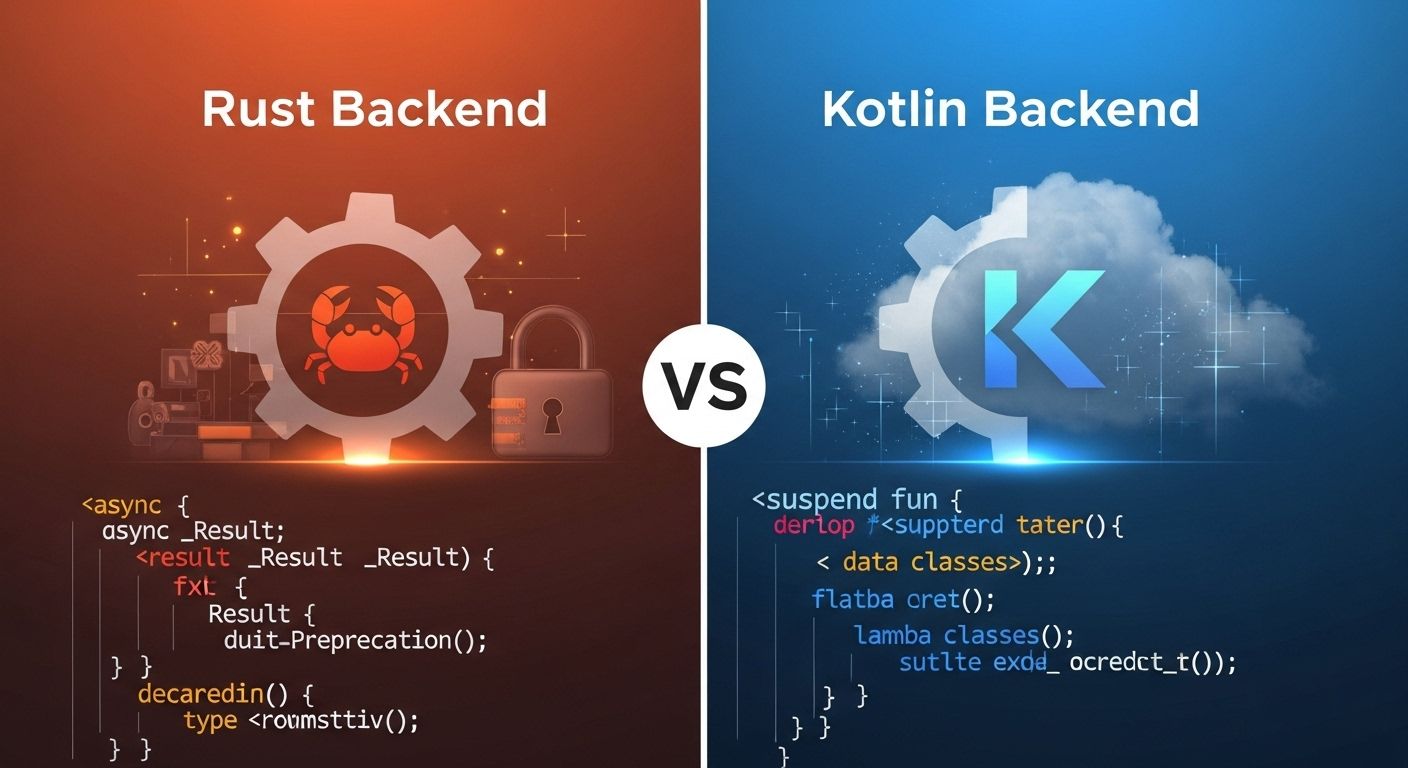The Backend Dilemma: Rust vs. Kotlin for Modern Services

In the ever-evolving landscape of backend development, developers are constantly seeking the optimal balance of performance, safety, and productivity. Kotlin, a modern language from JetBrains, has gained significant traction as a powerful and pragmatic choice for services running on the Java Virtual Machine (JVM). On the other hand, Rust, Mozilla’s systems programming language, is increasingly chosen for backend services where performance and memory safety are non-negotiable.
This post will explore the fundamental differences between building backends with Rust and Kotlin, comparing their approaches to performance, memory management, concurrency, and their surrounding ecosystems.
Head-to-Head Comparison: Rust vs. Kotlin
1. Performance and Memory Management
The most significant distinction lies in how each language manages memory and executes code.
-
Rust: Compiled, Fast, and No Garbage Collector: Rust is a compiled language that translates directly to machine code, offering performance comparable to C++. Its standout feature is the ownership and borrow checker system, which enforces memory safety at compile time. This eliminates the need for a garbage collector (GC), resulting in a minimal memory footprint and predictable, low-latency performance without the risk of GC pauses.
-
Kotlin: The JVM and Garbage Collection: Kotlin compiles to bytecode that runs on the JVM, which uses a Just-In-Time (JIT) compiler to optimize code at runtime. While the JVM is highly optimized, it can’t escape the overhead of its garbage collector. This can lead to higher memory consumption and potential latency spikes, which might be a concern for performance-critical applications. In one benchmark comparing multiple languages, a Kotlin-based REST API showed higher latency and memory usage under stress compared to its Rust counterpart.
2. Concurrency and Asynchronous Programming
Both languages offer robust solutions for handling concurrent tasks, but their models differ.
-
Rust’s “Fearless Concurrency”: Rust’s ownership model is a cornerstone of its concurrency story, preventing data races at compile time. It provides lightweight async/await syntax for asynchronous programming, allowing for efficient handling of many concurrent connections with minimal overhead. Frameworks like Tokio provide a powerful asynchronous runtime for building scalable network services.
-
Kotlin’s Coroutines: Kotlin introduced coroutines, which simplify asynchronous programming and are often described as lightweight threads. Managed by the Kotlin runtime, coroutines make it easier to write non-blocking code in a more readable, sequential style. This model is highly effective, though it relies on the underlying JVM for thread management, which may not be as performant as Rust’s approach.
3. Developer Experience and Learning Curve
Productivity and ease of use are critical factors in choosing a language.
-
Kotlin’s Gentle Learning Curve: For developers familiar with Java or other modern object-oriented languages, Kotlin is relatively easy to learn. Its concise syntax reduces boilerplate code, and features like null safety help prevent common errors. Backed by JetBrains, the tooling for Kotlin, especially within the IntelliJ IDEA ecosystem, is exceptional, boosting developer productivity.
-
Rust’s Steeper Climb: Rust presents a steeper learning curve, primarily due to its unique ownership, borrowing, and lifetime concepts. While these features provide immense safety benefits, they require a different way of thinking about memory management, which can be challenging for newcomers. However, many developers find that once they overcome this initial hurdle, the compiler’s strictness leads to more reliable code and fewer runtime errors.
4. Ecosystem and Maturity
A language is only as strong as its ecosystem of libraries and frameworks.
-
Kotlin’s JVM Advantage: Kotlin seamlessly interoperates with Java, giving it access to the vast and mature Java ecosystem. This includes a massive collection of libraries, frameworks like Spring and Ktor, and extensive community support. This makes it a highly productive choice, especially for enterprise-level applications.
-
Rust’s Growing Ecosystem: While younger, Rust’s ecosystem is expanding rapidly. Cargo, its package manager and build tool, simplifies dependency management. For web development, frameworks like Actix Web, Axum, and Rocket are gaining popularity and proving to be highly performant and suitable for building robust web servers.
“The fastest language means nothing if your team can’t ship features quickly, debug effectively, or onboard new talent efficiently.”
When to Choose Which?
The decision between Rust and Kotlin for backend development hinges on your project’s specific priorities.
Choose Rust if:
- Peak performance and low latency are critical requirements, such as in high-frequency trading, gaming backends, or real-time data processing.
- Memory safety and reliability are paramount, especially in systems programming or for services where bugs could have severe consequences.
- You need a small memory footprint to reduce server costs or run on resource-constrained devices like IoT hardware.
Choose Kotlin if:
- Developer productivity and rapid development are the top priorities.
- Your team is already skilled in Java or other JVM languages, allowing for a smooth transition.
- You need to leverage the extensive and mature ecosystem of Java libraries and frameworks like Spring.
- Your application is more I/O-bound than CPU-bound, making raw computational performance less of a bottleneck.
Conclusion
Both Rust and Kotlin are excellent languages that bring modern features and strong capabilities to backend development. Kotlin offers a pragmatic and productive path for building a wide range of applications, especially for those already invested in the JVM ecosystem. Rust, while more demanding to learn, provides unparalleled performance and safety guarantees, making it an ideal choice for services where every microsecond and byte of memory counts. Ultimately, the best choice depends on a careful evaluation of your project’s constraints, performance goals, and team expertise.